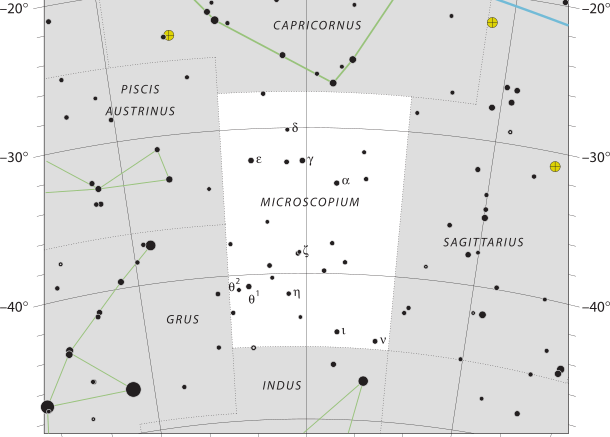Microscopium is a constellation that lies in the Southern Hemisphere. It was created in the 18th century by French astronomer Nicolas-Louis de Lacaille. The name is a Latinised form of the Greek word for microscope.
The stars in the constellation are of the 5th magnitude, meaning that the stars are faint and hard to view from the Pacific Northwest. for those in the Northern Hemisphere, the best viewing is from the tropical areas with a binocular. There are not any real bright deep sky objects in the constellation.
It is worth noting that 2 stars have been determined to contain exoplanets, while 2 others have debris surrounding them.
The constellation is the 66th largest constellation in the sky. It stretches for over 210 square degrees and like many other 18th century constellations, it represents a scientific instrument. In this case, it is named after the microscope.
| Applicable Information | |
| Visibility In Pacific Northwest | June to November |
| Best Times To View | September |
| Right Ascension | 21h |
| Declination | −36° |
| Area | 210 square degrees |
| Main Stars | 5 |
| Brightest Object | γ Mic |
| Meteor showers | Microscopids |
| Messier objects | 0 |
| Neighboring Constellations | Capricornus, Sagittarius, Telescopium, Indus, Grus, Piscis Austrinus |
Stars
French astronomer Nicolas-Louis de Lacaille charted and designated ten stars with the Bayer designations Alpha through to Iota in 1756. Within the constellation’s borders, there are 43 stars brighter than or equal to apparent magnitude 6.5.
Deep Sky Objects
Describing Microscopium has been described as “totally unremarkable”, some astronomers who said that there are no objects of interest for amateur observers. However, there are some interesting dec sky obects in the constellation.
NGC 6925 is a barred spiral galaxy of apparent magnitude 11.3 which is lens-shaped, as it lies almost edge-on to observers on Earth NGC 6923 lies nearby and is of a fainter magnitude.
The Microscopium Void is a roughly rectangular region of relatively empty space, bounded by incomplete sheets of galaxies from other voids.[37] The Microscopium Supercluster is an overdensity of galaxy clusters that was first noticed in the early 1990s.
Make sure to check out other articles on the site, including a brief introduction to constellations, other constellation articles, and more!

Be the first to comment on "Microscopium"